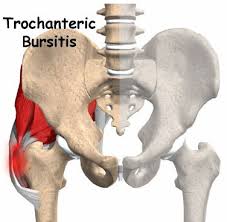What is hip bursitis?
Hip bursitis (also known as trochanteric bursitis) is inflammation of the bursa which lies over the bone on the outside your hip.

The human body has around 160 bursae which provide a cushion between your bones and your soft tissues. If you have trochanteric bursitis, this will affect and cause pain in your thighbone, the femur, and at the edge of your hip. The bony point on the edge of your hip is the greater trochanter.
There are many reasons why we may suffer at some point with this condition. Repetitive activities such as running, jumping, and even poor walking patterns can cause the bursa to become easily inflamed.
What are the early signs and symptoms of hip bursitis?
You may start to feel a lot of pain on the outside of your hip. The pain may feel sharp to you, but over time it may turn into more of a dull ache. Moving your hip (especially going up and down stairs and walking) will make your pain much worse.
Hoping it will go away on its own can end up causing more issues as the pain can start to radiate down your upper leg. When you lay on your side in bed or when you get up from a chair, you may feel a lot of discomfort and pain. It is suggested that you see your doctor as soon as you have discomfort for a couple of days so that they can make a quick diagnosis and start you on the road to recovery.
What causes hip bursitis?
Anyone can get hip bursitis, but active adults who do regular walking, running, and cycling may be more susceptible. The older you get, the higher the chances of getting this condition. Middle-aged or elderly people and women are generally more predisposed to this condition due to their hormones and anatomy.
Other causes of hip trochanteric bursitis include:
- Hip injuries
- Hip surgery complications
- Muscle tears
- Poor posture
- Arthritis
- Injuries from a fall
- Overuse from repetitive activities
- Standing for too long
- Legs that are two different lengths
How is hip bursitis diagnosed?
When examined by your doctor or physiotherapist, they will ask about your pain, lifestyle, and exercise routines. They will look and feel the painful region to assist their diagnosis. They may refer you for imaging to get a clearer understanding of your condition – and also rule out any other conditions that may be causing pain. In some cases, your doctor can inject a steroid into your hip to see if this helps.
What is the treatment for hip bursitis?
Treatments for this painful condition are usually non-surgical. These may include:
- Heat and ice packs
- Anti-inflammatory medication
- Regular physiotherapy
- Rest
- Cortisone injections
- Low-energy shock wave therapy
If none of the above help with symptoms and pain levels, the next step is to see a surgeon. Surgery is rarely required, but if the surgeon finds your bursa is beyond repair they will need to remove it. A surgeon will use an arthroscope device (a small camera directed into a small incision) so it is a non-invasive surgery and normally done as a day case operation.
How long does it take to recover from hip bursitis?
Many people respond well to physiotherapy within six weeks. In more chronic cases, it can sometimes take months to restore full strength and motion.
How physiotherapy can help your hip bursitis
We will do whatever we can to get you on the fastest route to recovery. Some of the treatment methods we use include:
- Mobilisation
- Strengthening exercises
- Myofascial trigger point release
- Pilates
- Cross-friction massage
- Stretching and range of movement exercises
- Acupuncture
- Functional exercises
- Kinesio-taping
